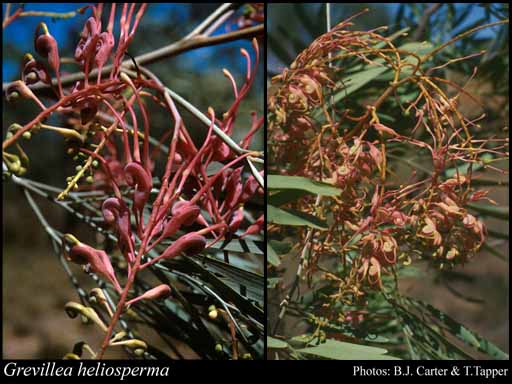- Reference
- Trans.Linn.Soc.London 10:176 (1810)
- Conservation Code
- Not threatened
- Naturalised Status
- Native to Western Australia
- Name Status
- Current
Small, spreading, sparingly branched, sometimes lignotuberous, tree or shrub, 2.5-8 m high. Fl. pink/red, Jan or Mar to Jul or Oct. Sandy clay, red loam, commonly on sandstone or laterite. Rocky hillsides, plateaus, other rocky sites.







Scientific Description
Trees or Shrubs, 3-8 m high; branchlets hairy, not glaucous. Leaves alternate, 80-400 mm long, hairy, on the abaxial surface, the hairs straight; lamina flat, once divided, pinnately divided, divided to the midrib; lobes 30-130 mm long, 5-10 mm wide, the margins flat. Inflorescences axillary or terminal, red or pink; pedicels 8-10 mm long. Perianth 10-14 mm long; tepals some joined and some free after flower opens, glabrous; ovary glabrous, stipitate, the stipe 9-12 mm long; pistil 35-40 mm long, red, pollen presenter oblique, style glabrous. Follicles glabrous, not viscid, dehiscent, 18-35 mm long. Flowers in May, June, July, August or September. Occurs in the Northern (N) Botanical Province(s), in the Northern Kimberley (NK), Victoria Bonaparte (VB), Central Kimberley (CK) or Dampierland (DL) IBRA subregion(s).
Distribution
- IBRA Regions
- Central Kimberley, Dampierland, Darwin Coastal, Northern Kimberley, Victoria Bonaparte.
- IBRA Subregions
- Berkeley, Hart, Keep, Mitchell, Mount Eliza, Pentecost, Pindanland.
- IMCRA Regions
- Kimberley.
- Local Government Areas (LGAs)
- Broome, Derby-West Kimberley, Halls Creek, Wyndham-East Kimberley.